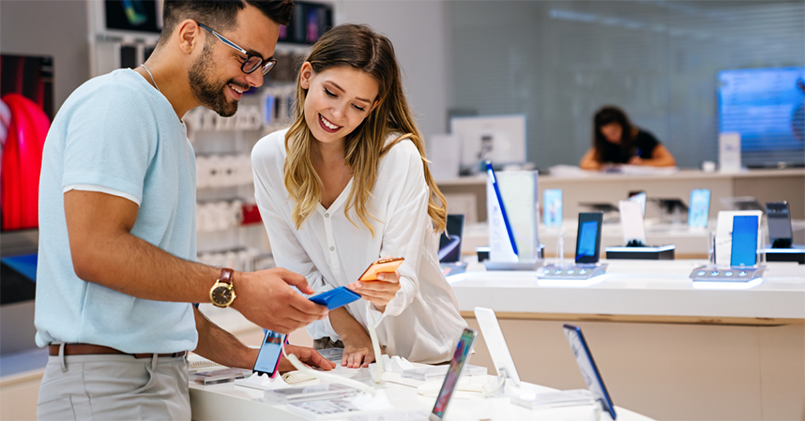Mobile phones have undoubtedly become an essential part of human life. Consumers depend on them to stay in touch with friends and family, watch entertainment, navigate where they are going, conduct their banking and so much more. Leaving the house without their phone is unthinkable, yet there will come a day when they will part ways with their old device and upgrade to a new one. But what happens to that old device? Many of them end up as e-waste. Each device that isn’t repurposed but set aside and eventually ending up in the trash is a missed opportunity for both wireless providers and consumers while also detrimental to the environment.
Though an owner may no longer have wanted their previous device, it most likely was still usable and held latent value. Used mobile devices can generate positive outcomes on multiple fronts if we can make the most out of their lifecycle.
Trade-in programs are solutions that can maximize the mobile device lifecycle and will yield benefits for consumers, businesses, and the environment.
The consumer variable
When it comes time to upgrade to a new device, the existing devices are handled mostly in one of three ways by their owners.
Some consumers, particularly those of the older generations (Baby Boomers and the Silent Generation), opt to keep the phone as a backup in case their new phone malfunctions, is misplaced or stolen; however, this option usually means that the phone is placed in a junk drawer and forgotten.
Other consumers prefer to try to sell their devices themselves, an action favored primarily by younger generations (Millennials and Gen Z). While preferred over placing in a drawer, it can be time consuming for someone to try to sell their own device and one may miss out on the lucrative promotions offered by the wireless providers.
Then there is the set of consumers that trade-in their old devices. This allows them to receive credit for that device to be put towards the new one. All devices that come through Assurant trade-in programs are data wiped with no risk of personal data being left on the device. Traded in devices are also kept out of landfills and those that cannot be repurposed are responsibly recycled.
Consumer sentiment around environmental sustainability should not be taken lightly. In a recent study, 75% of respondents stated that they would be likely to trade-in their device if they knew it would be properly recycled or reused. 85% of those in the same study said they would have a more positive view of their carrier if they focused on reducing the amount of waste that goes into landfills. And, this holiday season, 27% of consumers are considering buying a secondhand or refurbished device as a holiday gift.
All consumers should be made aware of the benefits of trade-in. Mobile carriers, OEMs, large retailers, and cable operators can encourage consumers to trade-in their old devices by extending compelling offers to turn in the device, as opposed to keeping them in a drawer or selling it online, and shedding light on the environmental good that comes from it.
The business component
The benefits to carriers, OEMs, retailers and cable operators that deploy trade-in programs are numerous. Trade-in promotions have proven to be successful marketing tools to encourage upgrades, increase customer retention and satisfaction, and attract new customers. Additionally, trade-in programs help these wireless providers achieve their own corporate sustainability goals.
Carriers, OEMs, retailers, and cable operators should also consider the additional streams of revenue trade-in delivers. Best-in-class programs provide incentives that not only entice consumers to upgrade to a new device and trade-in their existing one but leave enough margin to profit when the device is resold in the secondary market. Capitalizing on the programs to generate the most possible revenue is conceivable, particularly if they take heed of the factors that are most important to consumers.
For instance, when deciding whether to trade-in their phones, 58% of global consumers say that their decision hinges on price. Through trade-in programs, Assurant and our partners have helped put over $12B back into the hands of consumers. Using our easily configurable analytics, businesses can propose the most favorable prices to motivate customers to participate in the programs and yield a profit in the process.
For another 25% of global consumers, trustworthiness is the most important factor. This is beneficial to carriers, OEMs, large retailers, and cable operators whom consumers may be more liable to trust than lesser-known or less-established online retailers or consumer-to-consumer sales sites.
Trade-in programs serve as a tool to increase the customer base, help consumers upgrade to new devices, positively impact customer satisfaction, and increase revenue all while making a positive impact to the environment.
Overall environmental impact
We have mentioned that devices that are traded in avoid ending up in landfills, but the benefit to the environment doesn’t end there. Often, these devices are resold or set aside to support warranty and device protection claims. When a pre-owned device is repurposed, it means a new device does not need to be manufactured which avoids producing CO2 emissions and also reduces the amount of minerals needed to be mined to produce the device.
Since 2009, Assurant’s collective sustainability efforts have resulted in:
- 116M repurposed mobile devices
- 23,664 metric tons of e-waste redirected from landfills
- 6.4M metric tons of CO2 emissions avoidance
Furthermore, Assurant ensures that any phone that cannot be resold is responsibly recycled. In 2021 Assurant diverted 1.9 million devices to recycling which allows precious metals to be recovered and reused.
It is possible to make the most out of the mobile device lifecycle. Trade-in programs are a win-win-win for all parties involved—consumers, mobile carriers, OEMs, large retailers, and cable operators—and they help protect the environment.






